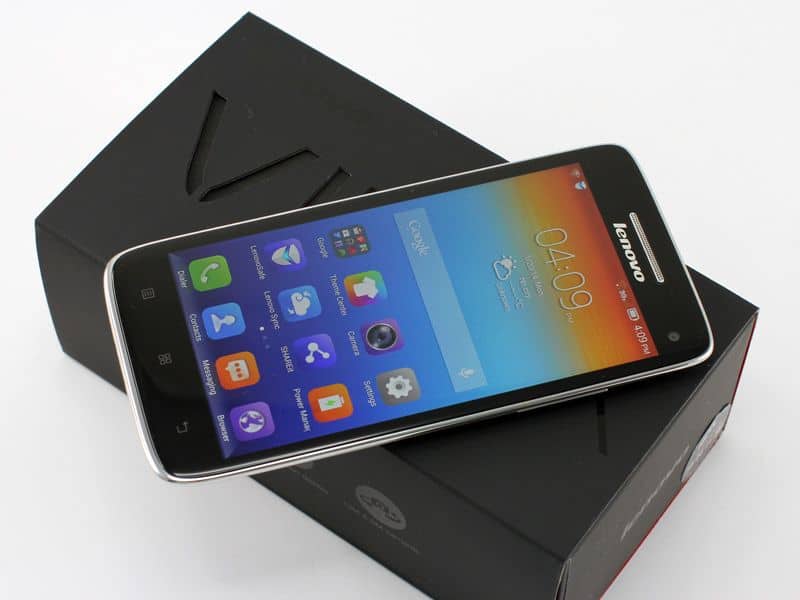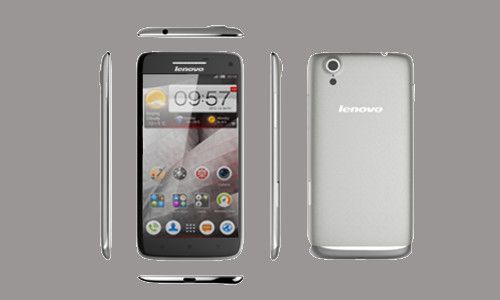Lenovo Vibe X configuration is quite “nice” with the quad-core chip, Full HD screen … but this smartphone works not smooth as expected. In return, it has a beautiful appearance, bright screen and front camera is 5 megapixel with a people like “take a selfie” to share on social networks.
Table of Contents
Design
Lenovo Vibe X lovely designed with soft lines, look not to whether there is a 5-inch screen. The weight of the machine is only 120 grams, the equivalent of the iPhone 5 only use 4-inch screen. Although slender, Vibe X still feels pleasant, certainly when holding. 6.9 mm thinness equals Lenovo k900 but Vibe X more attractive, especially to women, so that no box-shaped and slightly rounded corners beveled at the back.
The back cover is not removable and machine made from plastic but feels like metal, decorated delicate, enabling the machine not pick up fingerprints. Similarly, surrounded polycarbonate frame, plating a layer of metal shiny outside. Overall, the device is quite polished, but it is unclear whether to keep it looks bright in the process of using long time or not.
Volume button on the right side, power button located on the left side. Due to the slim design of the camera of Vibe X so slightly bulging and SIM slot is also slightly skewed to the back bench.
Overall, the design of the Vibe X pretty nice if users are not too interested in plastic or metal casing.
Screen
Another surprise in this mid-range smartphone 5-inch screen is quite nice with Full HD resolution, 441 ppi pixel density, the same Samsung Galaxy S4. Text and images are displayed smooth, clear and crisp, not pitting.
IPS technology also helps colors and good contrast. The screen has a wide viewing angle, bright enough and the quality has not changed significantly in the majority of circumstances of use, but not good enough under the sun.
The screen is equipped with Gorilla Glass 3 layer relatively high sensitivity and increase the product level. Large screen size but has a compact design helps Vibe X good support web browsing, social networking updates, e-mail, watch video …
Display
The display on the Lenovo Vibe X was one of its standout features. The device boasted a 5-inch IPS LCD with a Full HD resolution of 1920 x 1080 pixels, resulting in a pixel density of approximately 441 ppi. This was quite impressive for a mid-range smartphone in 2013, offering sharp and vibrant visuals that were ideal for everything from browsing the web to watching videos.
The color reproduction on the Vibe X’s display was generally accurate, with rich and vivid colors that made multimedia content pop. The viewing angles were also commendable, thanks to the IPS technology, which ensured that the screen remained clear and legible even when viewed from off-center positions.
Brightness levels were sufficient for indoor use and moderate outdoor use, although direct sunlight could still pose a challenge, as was the case with many smartphones of that era. The display was protected by Corning Gorilla Glass 3, which offered decent resistance to scratches and minor drops.
One downside of the Vibe X’s display was its tendency to be a bit oversaturated at times, which might not appeal to users who prefer more natural color tones. However, for most users, this was a minor issue, and the overall display quality was certainly a strong point for the Vibe X.
Camera
13 megapixel camera Vibe X, support for picture fairly, color stability and honest, but felt lacking contrast images. In low light conditions, software on the machine significantly reduces noise but makes the picture is not clear.
Highlights located in front camera with image sensor 5 MP – only appear in a few smartphones on the market. This shows that Lenovo is directed to young people like self-portraits to share on Facebook. It was so, when using the front camera, bottom of the screen will have more bar to smoothing adjustment levels from 1 to 7.
Regarding imaging features, Lenovo seems to take a bit more when equip different mode settings that users glitzy and reduce the speed of the operation.
SNAPit software provides many shooting modes in different environmental conditions. Thanks to a wide aperture (up to 84 degrees), the user can select the shooting mode Fish Eye to take “take a selfie” with a lot of people.
Meanwhile, the software to view and edit photo images SEEit support reasonable arrangements to view and allows editing directly on the photo just by touching your finger as whitening, smooth skin, large eyes more beautiful.
Performance
Vibe X is well configured but in reality is not as expected. Therefore, it will also have difficulty in attracting users because this segment is strong competition with formidable opponents like Google Nexus 5.
Lenovo’s smartphone uses 1.5 GHz quad-core MediaTek and RAM up to 2 GB, but the action is slow. This is what may be acceptable for a mid-range smartphone, however, the speed of Vibe X less than Lenovo K900, Nexus 5 and Samsung Galaxy SIII.
Latency of the machine can be clearly seen when users swipe the Home screen, open the app switcher or photo library. One reason for this may be due to the Vibe X run on Android 4.2.2 and Lenovo has customizable user interface different way.
Graphics performance of Vibe X disappointing when only 28.9 frames per second, according to the tool Nenamark 2. Meanwhile, one other smartphones also come from China, and also the same price as Huawei Ascend P6 reaches 60.9 frames/sec.
Despite its slim design, the battery life is quite good, can run all day if used in moderation. Besides, the machine has built-in battery management software and the user can select the mode depending on the need to extend the operating time of the battery.
Software and User Interface
The Lenovo Vibe X shipped with Android 4.2.2 Jelly Bean out of the box, customized with Lenovo’s proprietary user interface (UI) known as Vibe UI. Lenovo’s UI was a significant departure from stock Android, featuring a more colorful and playful design with plenty of customization options.
One of the most noticeable changes was the absence of an app drawer, a design choice that was more common in Chinese smartphones. Instead, all apps were placed on the home screens, similar to iOS, which might have been a polarizing feature for some users. However, this could be mitigated by installing third-party launchers that offered more familiar Android experiences.
Vibe UI offered a range of pre-installed apps and features, some of which were useful, while others felt like unnecessary bloatware. For instance, Lenovo included a theme engine that allowed users to customize the look and feel of their device, with options to change icons, wallpapers, and even system fonts. There were also several utility apps, such as a file manager, a backup tool, and a power management app that helped optimize battery life.
The overall software experience on the Vibe X was decent, but it was not without its flaws. The UI was not as polished or responsive as some of the more popular custom skins like Samsung’s TouchWiz or HTC’s Sense. Occasional lag and stuttering were noticeable, particularly when navigating through the system or switching between apps. Additionally, the phone did not receive timely software updates, with Lenovo’s track record for pushing Android updates being less than stellar.
Audio Quality
The Lenovo Vibe X featured a single speaker located at the back of the device, which was typical for smartphones in this price range during that period. The speaker was adequate for basic tasks like watching videos, playing music, and making hands-free calls, but it was not particularly impressive in terms of audio quality.
The sound produced by the speaker was reasonably loud, but it lacked depth and clarity, with a tendency to distort at higher volumes. Bass was minimal, and the overall audio experience felt flat, which might have disappointed users looking for a richer multimedia experience. The placement of the speaker on the back of the device also meant that sound could be muffled when the phone was placed on a flat surface.
For a better audio experience, users were better off using headphones. The Vibe X had a standard 3.5mm headphone jack, which was a welcome feature, allowing users to easily connect their preferred headphones or earphones without the need for adapters.
The phone’s call quality was generally good, with clear and crisp audio on both ends of the call. The built-in noise-cancellation feature helped reduce background noise during calls, making it easier to have conversations in noisy environments.
Conclusion
The Lenovo Vibe X was an ambitious attempt by Lenovo to establish itself as a serious player in the smartphone market. The device succeeded in delivering a stylish design, a high-quality display, and a decent overall user experience at a mid-range price point. Its slim and lightweight form factor made it a pleasure to use, and the 1080p display was a standout feature that set it apart from many of its competitors.
However, the Vibe X was not without its flaws. Its performance was adequate for most tasks but struggled under heavier loads, particularly in gaming. The lack of expandable storage, coupled with a modest 16 GB of internal storage, was a significant limitation, and the absence of 4G LTE support was a notable drawback as mobile networks evolved.
The camera, while capable of producing good photos in favorable conditions, struggled in low light, and the overall software experience was marred by occasional lag and the lack of timely updates.
In the end, the Lenovo Vibe X was a solid mid-range smartphone that offered good value for money, particularly for users who prioritized design and display quality. However, it faced stiff competition from other devices in its class, and its limitations in areas like performance, battery life, and software support might have led some users to consider alternative options.
For those who were willing to overlook these shortcomings, the Vibe X was a stylish and capable device that served its purpose well. However, for users with more demanding needs or those who valued long-term software support, other smartphones in the same price range might have offered a better overall experience.

